Moth traps reveal a rich nocturnal abundance in a suburban garden.
by Debbie Davitt
29th June 2024
First, a reassurance: no creatures were harmed in the creation of this blog… not even the wasps!
For 20 years our garden has been nurtured for nature. Over the years, and especially since 2020, it has been getting considerably wilder. In the daytime my husband Jeff and I have noticed lots more insects and butterflies, but what about at nighttime? We rarely venture out in the late evening – the midges around here are just too ferocious! I’d heard about moth trapping but wasn’t really sure what it involved, so when we had the chance of having a moth trap set up in our garden in Ilkley in August 2023 I jumped at it.
On the appointed day the forecast didn’t seem too promising – cool and showery – but Nyree (the butterfly recorder for the Wharfedale Naturalists Society) and David Fearnley were not too concerned. They arrived in the early evening, and we spent a little time exploring the garden to find the most suitable spots for not one but two traps.
Moths are famously attracted to light. Moth traps all work on a similar principle and tap into this behaviour. In its basic form the trap is a sturdy box with a bright light above it; a couple of panes of plastic sit just below the bulb, positioned at an angle with a gap between them at the base of the slope. Moths that hit the light or settle beneath it slip down the glass and through the gap. The box is filled with material that the moths can hide in – egg boxes seem to be perfect for providing nooks and crannies – so there is somewhere safe and dark for them to rest.
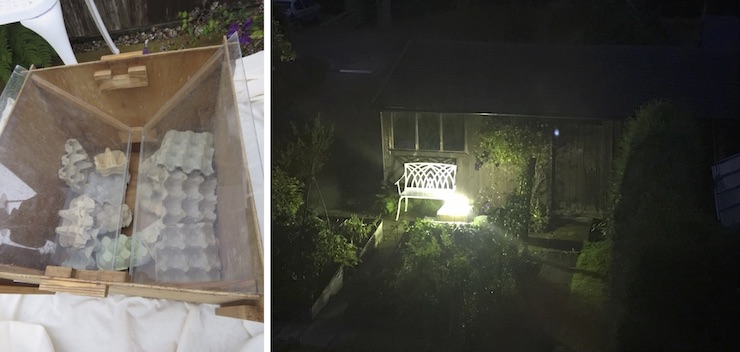
The first trap we set up used a mercury vapour light. These are extremely bright, so we took care to position it where it wouldn’t disturb the neighbours – and when we turned it on it really was dazzling! It required a mains power source and had to be switched on and off manually, so we used the power supply from the garden shed, spread a sheet out on the ground, and set it up near the mini meadow. Jeff heroically got up at dawn (5.30am) to pop down and turn the light off and, once the bulb had cooled enough, throw a sheet over the whole contraption to contain any moths which had settled around it. He was also instructed to check nearby plants and catch any resting moths in little plastic pots to identify later.
The second trap was a portable version, an Actinic Trap, which has a light-sensitive mechanism so that the bulb turns itself off at dawn. This one we placed at the other end of the garden by a native species hedge, young oak tree and the wildlife pond.
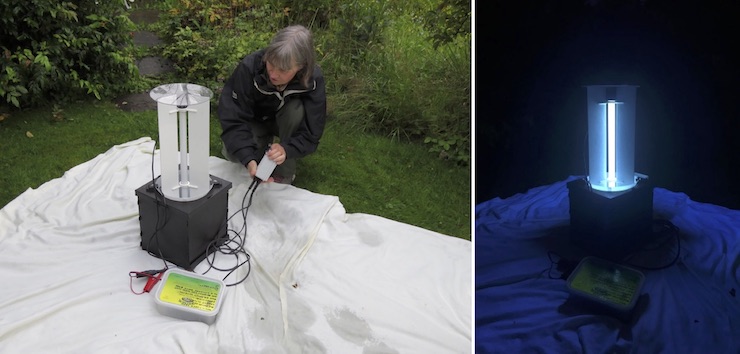
At 9am the next morning Nyree and David returned and we were joined by Dr Paul Millard, the recorder for Butterfly Conservation Yorkshire’s “VC65 North-west Yorkshire” area. Coffee was provided (one has to get one’s priorities right), and then the fun began! With plastic pots at the ready to capture any lingerers we started by looking at the area surrounding the traps: on the shed, on the ground, on nearby plants and on the ground sheet. Paul, Nyree and David spotted many camouflaged moths that Jeff and I didn’t see – the benefit of experience!
Since the weather was still rather drizzly, we set up a couple of trestle tables in the shelter of the open garage and moved the traps there. Gently the sheets were pulled aside to reveal moths resting in the folds. Carefully each trap was unpacked a little bit at a time to allow each insect to be identified and recorded. I was blown away by how many moths there were!
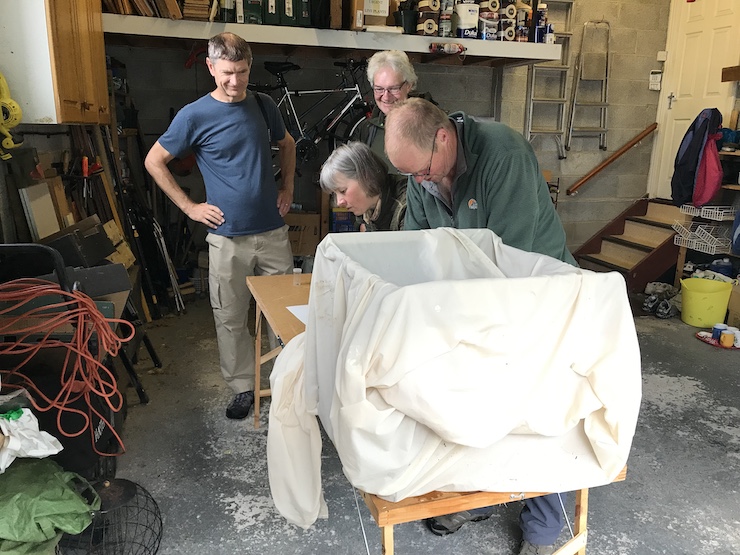
The excitement from the experts was infectious – like some kind of unwrapping of a huge, mystery pass-the-parcel! The more unusual moths were popped into a pot to enable a closer examination. Photos were taken to help check out details. Two apps in particular are recommended: ‘What’s Flying Tonight,’ which cleverly uses your location to inform you of what’s been recorded in that 10km square, tells you what species to expect to be on the wing at any given time of year, and helps with identification; and also ‘ObsIdentify,’ which we were told is the best one for moths. Nyree and David were great at identifying what we had, but it took Paul’s expertise to identify the Svesson’s Copper Underwing, which differs only slightly from the Copper Underwing. It was he who spotted the rarest find of the morning: a small, inconspicuous, mottled grey moth resting on a currant bush which turned out to be Cochylimorpha straminea, a species which had never before been recorded in this 10km square. Paul told us it was here because of the knapweed in the meadow area we created in 2020, so that was very gratifying!
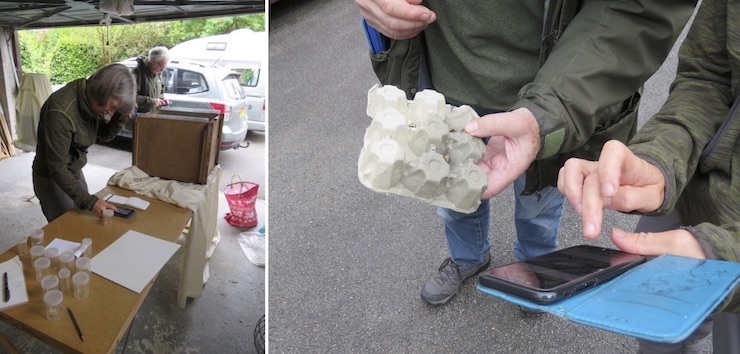
The more common moths have the most fabulous names: Willow Beauty, Riband Wave, Scalloped Oak, Dingy Footman (that one looks remarkably like a melon pip!), Clouded Border, Canary Shouldered Thorn. We also had a few TWORN (too worn to identify!) and dozens of dozy wasps. I was interested to see the Box Tree moth, with its delicate iridescent purple markings. The caterpillar of this species has been cursed by ornamental gardeners as it has spread across the UK munching topiary box hedges. We also had a Mint Moth, which I’m told also feeds on the marjoram (Oregano vulgare) which is self-seeding rather too readily across the garden at the moment.
The moths were generally docile having been woken gently from their slumber. It was surprisingly easy to see them close up, get a really good look and to photograph them. It was wonderful to see their markings and the antennae in detail. Some of these insects are so beautiful, and I had no idea they were living in the garden right beside us.
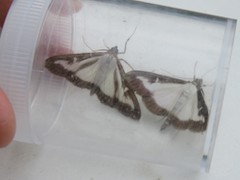
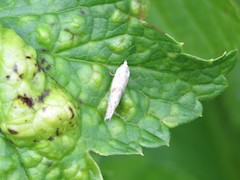
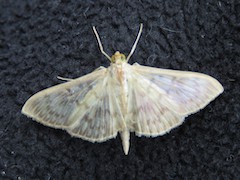
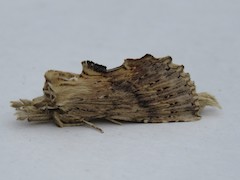
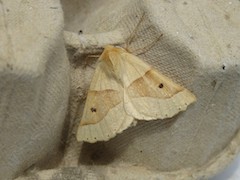
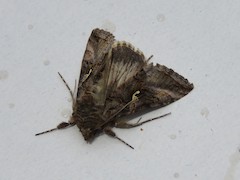
Once each specimen had been identified and logged, we set them free into the undergrowth in the hope that they would find a quiet corner to spend the daylight hours and not provide a buffet for the garden birds! Altogether it took us most of the morning. I was delighted that 36 species were recorded and 161 moths in total counted. The data was sent to the Vice-County Recorder for Moths and Butterflies and to the Wharfedale Naturalists Society for their records. A full list of species recorded is below, but the most numerous by far was the Large Yellow Underwing, a chunky moth that must provide a good food source for the local bats we see regularly.
Our thanks go to Nyree, David and Paul who so generously shared their knowledge with us and made it such an interesting and enjoyable morning. I was really blown away by the number and variety of moths in our relatively small, suburban garden. Without any baseline data we can never be sure, but I like to think that our rewilding, even on a small scale, is making a difference to biodiversity and abundance. If you get the chance to take part in a moth survey, I’d highly recommend it.
Finally, I’ll end with a plea: Please think twice before putting lights into your garden. They might look nice and light up your outside space like a grotto, but they give night flying creatures a real problem. Artificial light at night can impact wildlife in multiple ways, affecting navigation, physiology, breeding and general health. Many moths navigate in part by natural light sources like the moon, and can become disorientated by artificial light, wasting energy, increasing their risk of predation and reducing their efficiency as nocturnal pollinators. So, please, keep outdoor lighting to a minimum. Those beautiful moths will thank you.
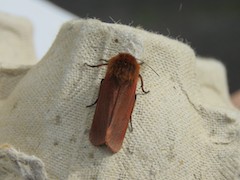
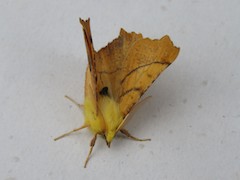

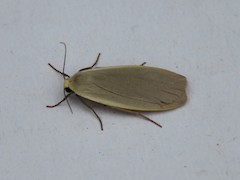
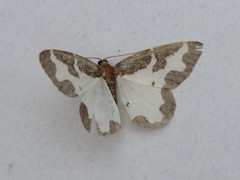
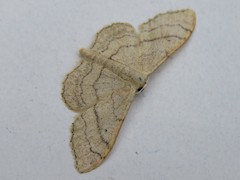
Moths recorded 3rd August 2023, Ben Rhydding, Ilkley, West Yorkshire:
| No. | Species |
|---|---|
| MV Trap: | |
| 10 | Agriphila straminella |
| 2 | Box Tree Moth |
| 2 | Brimstone Moth |
| 1 | Clouded Border |
| 1 | Cochylimorpha straminea |
| 1 | Common Carpet |
| 1 | Common Footman |
| 8 | Common Rustic Egg |
| 5 | Dark Arches |
| 1 | Dingy Footman |
| 1 | Double-striped Pug |
| 1 | Dun-bar |
| 1 | Eudonia lacustra |
| 1 | Eudonia mecurella |
| 55 | Large Yellow Underwing |
| 8 | Lesser Broad-bordered Yellow Underwing |
| 2 | Lesser Yellow Underwing |
| 1 | Mother of Pearl |
| 1 | Pale Prominent |
| 3 | Riband Wave |
| 1 | Scalloped Oak |
| 1 | Silver Y |
| 1 | Small Dotted Buff |
| 1 | Small Fan-footed Wave |
| 1 | Small Phoenix |
| 2 | Udea lutealis |
| 1 | Udea prunalis |
| 4 | Willow Beauty |
| 4 | Willow Ermine |
| 1 | Yellow-bordered Brindle |
| Actinic trap: | |
| 1 | Agriphila straminella |
| 4 | Blastobasis adustella |
| 1 | Brown House Moth |
| 1 | Canary-shouldered Thorn |
| 1 | Common Footman |
| 2 | Common Rustic Egg |
| 19 | Large Yellow Underwing |
| 1 | Marbled Beauty |
| 1 | Mint Moth (Pyrausta aurata) |
| 1 | Mother of Pearl |
| 1 | Ruby Tiger |
| 1 | Scalloped Oak |
| 1 | Small Dotted Buff |
| 1 | Svensson’s Copper Underwing |
| 2 | Willow Ermine |
| 161 | Total |
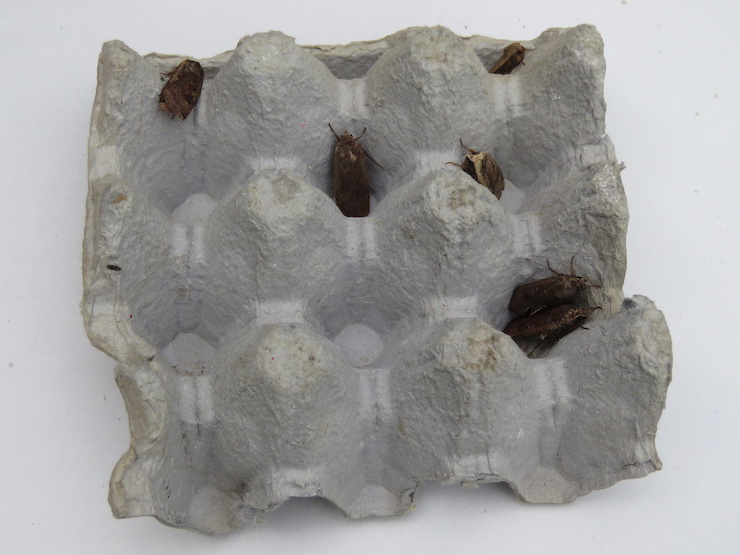
More information:
- Butterfly Conservation Yorkshire: https://www.yorkshirebutterflies.org.uk/
- What’s Flying Tonight: https://butterfly-conservation.org/moths/whats-flying-tonight
- Wildlife and garden lighting: https://www.rhs.org.uk/wildlife/garden-lighting-effects-on-wildlife
[Images: Jeff Davitt and Debbie Davitt]

